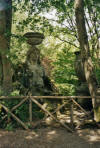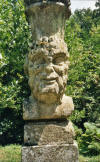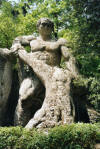|
Back to… The Aesthetics of Ruins (Home Page) |
Bomarzo
Built on Etruscan bones, petrified by the
Medusa's gaze: Bomarzo. A sixteenth century 'Sacro Bosco', a sacred wood lying in
a valley over-looked by a town of dark grey stone and a castle of even grimmer
aspect, surrounded by the hills and outcrops that border the Tiber valley,
route of the river to Rome and to the sea. As the
And there is a strange participation in the space around the 'monsters', the 'follies', the 'grotesques' whose actions are frozen as in a motionless tableaux. It is not only this surreal theatre that is caught in mid-performance, like a play in Pompeii turned to stone in mid-action, preserved for the arrival of our own amazed stare. For the virus of mimesis reduplicates itself in all that it touches. Here: a viewer freezes in sympathy with a statue. There: a mirroring in those that have entered; groups of viewers are themselves frozen before a group tableau.
One path even leads into an illusionist house, tilting to one side and half buried, as if caught in a mud slide, or trapped by the accumulated debris of time. The top of the rusticated bottom section and a bishop's seal -hat and keys- normally found decorating the piano nobile, protrude just above ground level underlining the character of the house as a survivor of some bygone disaster (today similar 'deconstructive' effects are found in Daniel Liebeskind's War Museum of the North).
Bomarzo is, as we pass from clearing to
clearing, like a Heideggerian thought-pathway through a theme park of the high
mannerist imaginary whose contents have been fashioned from history and myth.
Whereas Heidegger's pathways were supposed to lead to the establishment of
authentic relations with Creation (the making of peace by beings with Being)
the pathways of Bomarzo follow an itinerary which is illuminated by the flowers
of in-authenticity. Follies and fakes, mock buildings and false ruins; a
constructed disorder. An inauthentic pleasure garden figures desire through
mythic scenes where citation and parody combine to re-create an impossible
past, a landscape of the fantastic. The past is recycled for the erotic and
exotic ends of the present. There is nothing new in the
The omnipresence of the ruin in Bomarzo. The past as ruin; the ruin of the past. The past as play thing. Momento (mori) as heritage. A support to self image. Like a school or training ground, a creator and maintainer of types of self, of identity. The identity of a caste and its privileged imagination - its foremost privilege (something denied even to the priest caste) that of freedom of thought; to leap and explore; to configure and reconfigure. A thought then materialised, a physical manifestation of ideas and games, in a set of experimental recombinations, lubricated with pleasure; a prototype for the Baroque pleasure garden. An out-pouring of mind into the mould of a received form; which is then broken and rearranged; hardening again, it sets into the foundation of a new mould; this latter itself breaking open to reveal its contents - at once architecture, sculpture, and landscape. Yet always a symptom of mind, a material prop to further growth, to a further spanning of the infinite, the leap into the unknown that is the symbiosis of matter and mind, of nature and culture, of stone and spirit.
And the future of the ruin: the reflection of the ruin as future. Contrary to the (popular) reading of the ruin as the fall of the powerful, for the powerful themselves the ruin-in-the-garden is the sign of their ability to incorporate disaster into play. The ruin-as-folly is the mark of the wealthy; expenditure on ruins (apparently 'wasteful' expenditure, as on pleasure gardens) signals the identity of the owner and his caste position. The dream of the future has been brought back, already realised - deferral of the good life is no longer a necessity. The private, individual, or caste exploration of the aristocratic utopia has already pre-empted the luminous vision of heaven on earth: indeed the latter may in this light be read as the by-product of actual rule, the practical everyday utopia of the ruling classes (whence the idea's 'material base'). Hence the reference beyond Christian piety to pagan mythology. The garden with its ruin is the site of the performance of utopia and not just its wish; power enables the indicative, pre-empting subjunctive hope. Heaven on earth; more suitable as an ideology for the self-obsessed masters of the world (with their honour code, keystone of the drama of the period) more especially if that world was also the world ordered by ideas, the rational world (building up to its logical end product, the enlightenment despot). This actually-existing caste-utopia is then transposed down, to the middle, and then to the powerless (to the would-be leaders of the new utopia). However for most its function will be subsumed by the church. The best critique of utopian thought is its aping of yesterday's ruling castes.
The presence of statues... no matter how alien, the nearest relatives to these creatures are (unless some animal, and perhaps even then) only ourselves. Yet how many realise that the spectacle before them is a mirror. The statues of Bomarzo: reflectors of power (real or imagined), a concrete image of the eternal subjunctive transformation that is ourselves within - as well as the horrors of the hidden indicative, the unconscious. The statue as lyric (as prosopopoeia). Always the content is that of the oldest genres: as complaint; as confession; as an expression of the inner sacred, the fantastic. In three interrelated forms: the excess of leisure (where the gentle flickering of candlelight is found, to the delight of the spectators, to be capable of inflicting a burn); domination (sadism and recognition); and the disaster as spectacle. History as the spectacle of disaster - the panoramic tragedy and comedy of peoples, fit fare for elite entertainment (or for those whose entertainment consists of believing themselves to be of the elite). Thinkers too have always had the past as their 'society of spectacle' (this long before Benjamin and Debord). For those who are powerless yet historically literate, for the priest caste, like today's intellectual, the spectacle of history is thus always a source of consolation and revenge (with panoptic delusions of the 'last word' to rival any aristocratic hubris). Ressentiment too is an aspect of the reflection on the ruin as disaster, of the statue as ruin. Furthermore, an observation taken from the past can also become a forecast. Now it is the landscape of the future that appears before us as the site of revenge ('Life is long', counsels an Islamic sage). Witness Shelley's ironic citation taken from the sunken statue of a forgotten tyrant; 'Look on ye mighty and despair'. It is not the historian but the Janus-faced prophet of the apocalypse who finally rules the sense of this figure.
If in many cases the 'Italian Garden' is today largely of 19th century origin (often funded by members of the English aristocracy who lost their hearts to the Italian landscape during the Grand Tour) nevertheless there were gardens in Italy before long this period and Bomarzo is one that has survived both neglect and reconstruction. Yet whatever its origins, whatever its stated intention, the construction of a garden is always marked by the pursuit of a chimera; the aim is found to slip away towards an ever more distant target, half-concealed, faint, unclear, whose trace offers its residual glow to creation's work. It is the stolen foretaste of heaven on earth that constitutes the utopian lining, reflection, or foundation behind the enchantment of the garden. Yet the white glow around otherwise profane objects is, by the light of the restless child within, transformed into the red lure of utility and desire. The garden now configures the world as plaything for the monstrous ego; the flip-side of a humanism that has lost its sense of the sacred. By contrast to the Garden, Bomarzo is a parody; the negative image of the dreamt-of place where fruitful plenitude is the rule, the grape is ripe forever, and the lion will lie down with the lamb.
Above all other human designs, the garden is the place where Nature and Culture are felt to be most in harmony. Safe Nature: 'natural' Culture. A cosy symbiosis. Yet out of the gash between the two the barely tamed forces of mythology emerge, emerging like elemental lava, only to cool in the rarefied air of civilisation, to remain, immobile, in the extravagant forms and postures in which they emerged from their subterranean realm. Still they possess the power to scare children and stir the imagination of their elders with the promise of a revelry without limits (a Darwinism in which, each, believing themselves to be Saturn, does not foresee the possibility of being eaten).
This taming of the elements, extending even to the gods of the underworld themselves, is a function of aristocratic pride, and an integral part of its training. Another name for it is harmony; the gift of the gods (which they may, however, like their sub-lunary imitators remove at a whim) or of reason in pursuit of an ideal. Or of reason's concealed puppet master; the will (itself in thrall to the insatiable demands of recognition and desire). Harmony as control (as with the balancing act of dictators); a product of mind, but contriving to appear natural; the cultural part hiding behind its favourite mask, the natural; synecdoche of illusionism. (Remembering that the greatest illusion is to consider oneself beyond illusion; the product, an enlightenment fundamentalism that, standing before the mirror, believes itself to be gazing out of a window onto an landscape which no longer has any surprises to offer).
If a longed-for aspect of gardens in general is to offer the rest of the grave before the grave, the gift of peace, the haven as a prequel to heaven, a sense figured through the suggestion of an other-worldly landscape; then reflecting its presiding genius, Bomarzo has turned this source of consolation into a vision of hell.
The very arrogance of the pleasure garden; using all manner of things, even time and the decay of things, earthbound intimations of eternity and the terror-laden tracks of entropy itself, for its own satisfied insatiability. Like an infant to whom all is but the breast or its absence, and not somehow the reminder of a pious lack of self, as suggested by some aestheticians (as if piety was ever a source of the lack of self). Bomarzo gives the lie to this school of art criticism.
The arrogance of aristocratic time; but also of human time writ large. Remove the cinematic flicker of past, present and future in its everyday flux and all beliefs will be found to employ the other side of time to frame and fix their 'world', to freeze the river of contingency (like the petrified forms that haunt the park). Stilling the polyphonic chatter of voices from the past and from the future - clearing a path for a voice claiming to speak for the present, claiming to speak from the invisible steadfastness of the other side (the universalism of an unaxiomatised Reason included). The eternal present feeding the illusion of the presence of eternity; a sleight of hand that enslaves the present even as it builds upon its inescapable presence. A gift of the Other in (the) place of the other (just as modern philosophy finds itself torn between others and Others). A making still, a making stone, with statues as tablets of stone, fixing a thought forever (a thought forgotten in the passage of time) unthought by the new inhabitants of the garden, innocent tourists untroubled by the chains of another's sublime. The arrogance of consumer time (basic unit, the photo-shot). The instant, liberated from eternity, only to be enchained by chemistry and digital technology.
Bomarzo: only the reflection of the tourist's itinerary remains; yet the odd ripple still disturbs the seamless surface of the mirror, an indication of the passing of some hidden Behemoth.
Copyright © 2003, 2005 Peter Nesteruk


